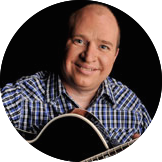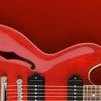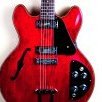-
Posts
283 -
Joined
-
Last visited
-
Days Won
12
Content Type
Profiles
Forums
Gallery
Events
Articles
Blogs
Downloads
Community Map
Posts posted by Plantsman13
-
-
Gerald,
Thanks for taking the time to elaborate. It is appreciated. I'm definitely new to the jazz way of approaching music (in other words, I'm facing a very steep learning curve).
Bryan
-
Question regarding the 6th string root chords: Steve states the 5th string is never played but I've learned the Gm7 barre chord utilizes the fifth string D. In fact, Steve mentions you can rest the ring finger in his video. Why is it being omitted in a jazz context?
-
@UncleHammy That's a bad visual...let's make an exception and take Dave's word this time!

-
 1
1
-
 2
2
-
-
Sweet looking LP. Hope it brings you years of wonderful music. Congrats.
-
Slow and steady for sure. Once I get them under my fingers, I then work on closing my eyes or looking away from the fretboard while I try to execute them cleanly. I even like to work on a swing rhythm to drill down even further on the muscle memory. Another mind exercise is to start the scale on a different note than normal and either go forward or backward. I find this keeps things more interesting over just rote repetition; however, one must put in the time and effort originally to get the different scales under your fingers before exploring these alternate avenues to reenforce what you have learned. Another good technique is to practice on your hammer-ons and pull-offs while working on your scales (Steve works on this in his Fingerstyle course).
-
Shelby Foote could make listening to him reading from a telephone directory very entertaining. Always loved listening to his "interviews/interpretations" on his favorite topic.
-
 1
1
-
-
Definitely a Ben, but similar to a blind pig finding an acorn once in a while! I've researched acoustic tone-woods and body shapes while my skill set resembled "chop sticks" on a piano. How does one "feel" a guitar talk to you at that stage of development? You go into a "guitar shop" and somebody next to you rips off a "SRV" or "Julian Lage" set of licks while you worry about "chop sticks". Not good. We all want to believe that signature model we've seen will allow us to play and sound better...but it doesn't. My point is I think beginning guitarists need to learn how to play fundamentally before being stricken with G.A.S.ed overload. I love boutique acoustic guitars, with attention to construction detail, that make my heart sing...even if I sound like a scalded cat while playing it. :-)
-
 1
1
-
-
Sey,
Steve did a video on his thoughts I've inserted here:
I'm personally guilty of "too many irons in the fire", but it helps me to bounce into my learning barrier in multiple spots versus digging a rut at one location. :-) Steve says it right in his video.
Good luck in finding a practice routine that leads you down a road to more success in your guitar playing.
-
Sure. I graduated from Naperville Central HS in '73. Back when it first put up 25,000 population signs...prior to fastest growing city in Illinois boom.
-
@matonanjin McHenry County, city of Crystal Lake, Northwest suburb. Next door to Woodstock , IL where they filmed Bill Murray in Groundhog Day :-)
-
Today's Chicago Tribune had an interesting piece on David Bowie today. Irregardless of your musical tastes, he did cast a large shadow over musical creativity of our time.
Enjoy!
-
 2
2
-
-
Doug,
Beautiful guitar! Hope you enjoy "running across the keys" with it. ;-) Landing a great guitar at a great price just lends itself to a smooth combo. Congratulations
-
I've had two rotator cuff surgeries on my shoulders, so I understand smaller is better when it comes to acoustic guitars. Dreads are in my rearview mirror and I've had good comfort with Taylor Grand Concert acoustic guitars. I haven't played the Academy 12e guitars but reviews have them respectable values/quality for the price range you mention. Watch for something used, if it were me.
Good luck in your search.
-
 1
1
-
-
TE is definitely the entertainer with a guitar (and phenomenal live); but Eric Skye gets my "smooth, in the groove" vote. From fiddle tunes, Miles Davis blues, to Herbie Hancock...he gets it done on an acoustic guitar. Here's a tribute to the late Glenn Campbell..enjoy.
-
 2
2
-
-
That's a real beauty! Enjoy its tone as well. Congrats.
-
In the case or not...I have multiple guitars (acoustic and electric) that are kept in their cases when not being played. I have heard and concur with the advice, the case is the safest place to keep a guitar when not being played. Chicago winters challenge the humidity issue, and even 35% house humidification during 0 - 15 degree weather results in significant window condensation. A room humidifier is also used in my guitar sanctuary at night to boost humidity levels. I keep MusicNomad sound hole humidifiers and Dampits (larger model) in the peghead compartment of each acoustic and single Dampit in the electric. I do use distilled water in these devices, as recommended by MusicNomad, to avoid scale buildup from our hard water.
I do not keep any guitars outside of their cases for the humidity issues and my Brittany Spaniel's rambunctious behavior during various times of the day. I try to keep regular practice times, then keep them safe when finished.
Extended storage periods does make me think of relieving string tension. Is there a recommended amount of string relief, such as half-tone, full-tone, or perhaps more?
-
 1
1
-
-
-G. No worries. ?
-
I use mine exclusively with my Traveler Sportster when I fly or drive on trips away from home. Packs well with a small footprint. I own the British tone model. I normally use headphones, but I'm trying my phone earbuds this trip to minimize luggage space. We'll see in the morning when I practice.
-
The omission of "classical" made me start humming ELO's version of "Roll over Beethoven".
-
Thanks for the information. I'll give it a try!
-
Mark,
90 bpm based on quarter notes does mean two eighth notes per beat (1+2+etc) that is equivalent to 180 notes per minute.
When you get to sixteenth notes; the 90 bpm will mean four sixteenth notes per beat (1 e and a 2 e and a etc) that is equivalent to 360 notes per minute.
Steve's progression does keep things relative as you practice to obtain 120 bpm using sixteenth notes. If you have mastered eighth notes at 90 bpm; go back to quarter notes at 90 bpm and it'll feel like time stood still!
I think your confusion is Steve cycles through all bpm (60-120) using "quarters'; then "eighths", then "sixteenths".
-
Can I borrow your wife the next time I plan to go guitar shopping...just kidding, I'm jealous on both parts.
 That is a stunning guitar. Enjoy its tone and weight.
That is a stunning guitar. Enjoy its tone and weight.
-
 1
1
-
-
I think of the number as an expression of "mm" thickness, but I have no experience with Bluechip. I have the impression the how the material "feels" while playing is the "artistic" measure, with tortoise shell picks setting the bar (at least from comments read over the years).
I believe the material is similar but shape and size differ. Looking at Wegen, there is a very large array of picks manufactured to meet differing tastes and demands.
-
 1
1
-
-
Cindy,
You can order online here:
OBTW: when Julian Lage and Chris Thile (among others) endorse them, you might be able to overlook the cost. I chose Wegen for cost and Jack Pearson recommended them last summer at GG. A four pack of bluegrass ran $15 while the TF100 ran $15 each at Elderly in Michigan. Offered in white or black as shown in earlier picture.
Quote-
 1
1
-







NGWE (x2)
in Guitar Gear, Amps, Effects, Pedals
Posted
Dave,
Really sweet looking instruments. L-00's have always intrigued me, so congratulations on your find (I too believed McP's claim to originality on cantilevered fretboards). Perhaps your and Barbera should work on a duet routine with vintage Gibby L-00s.